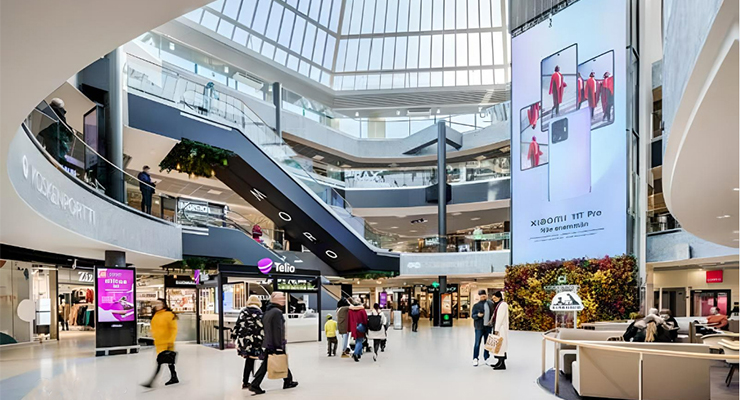By Jean Carlos Delgado
Being a quality player in the shopping center industry can manifest in various forms – through its ambiance, the mix of retail and entertainment options, sustainability initiatives, mixed-use offerings, or the seamless integration of digital conveniences. While numerous factors influence the success of a shopping center, I will draw on insights from industry leaders, real-life case studies, and my own personal reflections to focus on three key factors that establish a shopping center as a quality player.
Tenant Mix: Quality With The Right Diversity
It is evident that a well-curated and thoughtful selection of tenants creates a vibrant, dynamic environment that attracts a broad spectrum of visitors, ensuring the shopping center remains a thriving community hub. In search of frontline expertise on the topic, I contacted Jussi Vyyryläinen, an expert with nearly two decades in the industry, and asked him about the key considerations or principles he believes are important when curating a tenant mix for shopping centers.
“The key to the right tenant mix is understanding the catchment area and the consumers’ expectations there. That includes the demographics, consumer behavior, and competition, to name a few examples, but extends also to understanding the change happening among the consumers and the particular area. There is no one recipe for the right tenant mix, but instead, it needs to be defined on a case-by-case basis,” states Jussi Vyyryläinen, Senior Vice President / Group Head of Leasing & Specialty Leasing, Citycon.
I couldn’t agree more with him that there’s no one-size-fits-all recipe for the right tenant mix— much like life in general, where flexibility and adaptability are key to success. Jussi’s extensive experience reveals the importance of anticipating market trends and adapting the tenant mix before shifts become a necessity. This forward-thinking strategy ensures the shopping center remains relevant and attractive to shoppers, thereby maintaining its quality and competitiveness.
Jussi shared a compelling example of this proactive strategy: “We have carried out various strategic tenant mix conversions, and we have executed them early. Instead of waiting for a tenant or a tenant group to start suffering, we execute conversions when everything is stable, but we understand that that will not be the case in the future unless we act. The change might be triggered by new competition or a change in consumer behavior. For example, we have made conversions from retail to services and from fashion to groceries; we have also carried out other types of conversions, depending on the case at hand.”

Sustainability: Defining Quality Leadership At Shopping Centers
For those of us immersed in the retail industry, it’s clear that sustainability has evolved from a buzzword to a critical component of quality shopping centers. As I wanted to dive deeper into this crucial aspect, I spoke with Pia Rosvall, an expert in the industry with over two decades of experience and a staunch advocate for sustainable development in commercial real estate. Pia’s insights shed light on why sustainability has to be seen as a key factor for becoming a quality player in the shopping center industry. I was curious about her perspective on how shopping centers integrate sustainable practices to enhance environmental responsibility and attract eco-conscious consumers. “Sustainability transcends trendiness; it’s the foundation of a forward-thinking business strategy. Integrating eco-friendly technologies and sustainable practices positions a shopping center as a leader in innovation and community development. It’s about creating spaces that not only serve consumers but also inspire them to embrace a sustainable lifestyle,” states Pia Rosvall, Shopping Centre Manager, Kluuvi.
Pia’s approach to sustainability goes beyond typical measures. She highlighted the need for easy access to amenities such as easy access to charging stations for electric vehicles, recycling centers, and public transportation, which not only reduce the carbon footprint but also enhance convenience for shoppers. “The most ecological way is to have the shopping center in a strategic location,” Pia noted. “It’s all about location, location, location. Shoppers want everything to be five minutes away from their homes, with no driving needed.” Such initiatives demonstrate a commitment to creating a sustainable environment that aligns with the values of modern consumers.

Senior Vice President / Group Head of Leasing & Specialty Leasing, Citycon. /// credit: HyperIn, Citycon, Olga Poppius
Technological Integration: The Cornerstone Of Quality Shopping Centers
As we navigate the merging of digital advancements with the traditional retail environment, it’s clear that technology has moved beyond mere operational support to become a critical element in driving consumer engagement and boosting revenue growth. In an era where the boundaries between online and offline shopping blur, choosing the right technological partners is essential for distinguishing a shopping center as a premier destination for quality.
This perspective led me to engage in a discussion with Markus Porvari, a seasoned technology entrepreneur and the founder of HyperIn, to explore why technology is so crucial for quality in shopping center management and consumer interaction.
“Technology’s role in modern shopping centers goes beyond mere operational support; it’s fundamentally reshaping environments to connect with today’s tech-savvy consumer. Integrating intelligent systems to create interactive, immersive experiences that engage visitors at every level are what distinguishes a quality venue in the competitive landscape of tomorrow,” argues Markus Porvari, President and CEO at HyperIn.
In our conversation he also emphasized on some practical applications of these technologies: “Take our work with Citycon’s shopping centers digital signage screens in the Nordics which do more than just display real-time information or guide shoppers — they also offer data and analytics to shopping center managers, helping them make informed decisions to engage with visitors in effective ways.”
Porvari also touched on how quality shopping centers are rapidly evolving into mixed-use spaces, integrating technology in residential and industrial areas to meet broader community needs. “In Hong Kong, we are working with local authorities to deploy our mobile intranet solutions with features like electronic identification cards and real-time footfall analytics at business parks connected to shopping centers. This technological approach not only fortifies the management and security measures but also significantly elevates the quality of the local environment.”
This comprehensive approach to technological integration highlights why it is a cornerstone of quality in modern shopping centers, setting new standards for urban development, and paving the way for smart cities of the future.
Tenant mix, sustainability, and technology integration are not just components but the pillars of a high-quality shopping center. Focusing on these key factors allows shopping centers to position themselves as leaders in the industry, offering a superior experience to visitors while contributing positively to the planet. The future of commercial real estate is bright, with endless potential for innovation in management, consumer engagement, and revenue generation. As we look forward to what’s coming, the emphasis on quality will undoubtedly shape the shopping centers of tomorrow into vibrant, sustainable community hubs.






